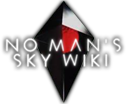| The subject of this article is from the Atlas Rises update.
The information from this article is up-to-date as of 23 July, 2018. |
The information from this article is up-to-date as of 23 July, 2018.
THIS PAGE IS A WORK IN PROGRESS. Please do not edit for now.

Naming guidelines for the Vestroga Hub Foundation.
Full Examples[ | ]
The following are examples of possible system names using both the primary tag and secondary tags. Note that these are just "imaginary" - they don't actually correspond to any in-game locations.
Solar Systems[ | ]
- [VHF1-79] SystemName (3.9m Shark, KsMuVC)
This system is located in the first (core) region (Vestroga Nebula). A record-breaking shark can be found in this system. Available resources include Kelp Sacs, Murrine, and Vortex Cubes.
- [VHF4-$-7A] SystemName (8m Diplo, CaRaGB)
This system is located in the fourth region of the Vestroga Hub (Rezital Mass). It has a wealthy economy, and ~8 meter diplos can be found here. Available resources include Calium, Radnox, and Gravitino Balls.
- [VHF11-!X-2] SystemName (Alien MT, X.Ship, SV)
This system is located in the eleventh region of the Vestroga Hub (Oikawai). It has a high conflict level. At least one exotic planet can be found here, along with an alien multitool and an Exotic Ship that may be especially nice. Available resources include Sac Venom.
Planets[ | ]
- PlanetName (ThPu, Geo, Barren)
This planet contains no fauna, and no flora besides standard resource plants and possibly the occasional mushroom. It has some type of interesting geological formations. Available resources include Thamium9 and Plutonium.
- PlanetName (AlienMT, Mu, HiPop)
This planet contains an Alien Multitool (ideally marked by Communications Station) and has a high population (frequent buildings). Available resources include Murrine.
- {!} PlanetName (Fauna-rich, Ra, Ext. Heat)
Many fauna species can be found on this planet with ease. The Sentinels are hostile, and the planet experiences extreme heat. Available resources include Radnox.
Primary Tag - [VHFn-!$X-###] - Mandatory[ | ]
NOTE: There is no way to actually enforce the mandatory nature of this tag, but if you choose not to use it, you'll be doing a disservice to your fellow Vestrogans. On the other hand, we all make mistakes, so don't feel bad if you upload a "[VHF7-" system - we've all been there, but try to avoid it.
The "main" or "primary" tag is the most important part of our naming guidelines, and conveys a lot of information in a compact space.
Part 1 - VHFn, Hub Marker & Region Number[ | ]
1. VHF Marker & Region Number - This part is simple - it just lets people know this system is Galactic Hub space, and which part of our space. Its format is [VHFn, where "n" is the region number:
The Vestroga Hub maintains the following 11 regions, which make up the Vestroga Tree. The Vestroga Hub also occupies a number of "Huburb" regions in an unofficial capacity.
| REGION NAME | REGION # | DESCRIPTION | NICKNAME |
|---|---|---|---|
| Vestroga Nebula | Region 1 | Capital Region | The Tree |
| Lecenut | Region 2 | Exploration Region | |
| Iletaniy Shallows | Region 3 | The Fauna Region | |
| Rezital Mass | Region 4 | Exocraft Region | The Racing Limb |
| Airman Instability | Region 5 | Tactical Region | Military Branch |
| Qanangn Mass | Region 6 | Scientific Region | |
| Omyasi Spur | Region 7 | Mercantile Region | Trader's Hub |
| Lenjungk | Region 8 | Harbor Region | |
| Gupanco Expanse | Region 9 | Agricultural Region | The Verdant Branch |
| Zuwanje Cluster | Region 10 | Prosperous Region | The Upper Tree |
| Oikawai | Region 11 | Paradise Region | Vacation Roots |
So for the Iletaniy Shallows, for example, all tags within that region would begin with "[VHF3".
Part 2 - !$X, System Info[ | ]
2. System Info - This part lists a few important characteristics of the system.
- A high-conflict system is marked with a "!", while systems with average or low conflict are not marked at all.
- A high-wealth / prosperous-economy system is marked with a "$", while average or low economy systems are not marked at all. (See Economy - Wealth)
- A system with an Exotic Planet - any planet biomes besides Lush, Toxic, Hot, Cold, Desert, Radiation, or normal Barren / Low Atmosphere - is marked with an X.
Part 3 - ###, Solar Index[ | ]
3. Solar Index - This part lists the fourth numerical portion of a coordinate sequence, with the left zeros dropped. For example, if the coordinate string was "09D6:0082:0DDD:0001", the solar index is "1". If the coordinate string is "09D6:0082:0DDD:0210", the solar index is 210. The zero(s) on the left is dropped because it's just "padding," 0210 is no different than 210. The zero on the right is retained, as 210 is different from 21. The solar index portion may be one, two, or three characters long.
If this is too confusing, just retain all 0's.
Coordinate strings can be located by pressing up on the D-Pad, or PC equivalent, and then building a Signal Booster.
It's also worth noting that solar indexes of 79 are always Black Holes, and solar indexes of 7A are always Atlas Stations.
Examples[ | ]
These are all combined using hyphens and square brackets, so some examples of final Main Tags could be:
- [VHF1-211], this system is in the core region. It has an average/low economy & conflict level, no exotic planets, and its solar index is 211 (displayed as 0211 in-game).
- [VHF8-!X-1], this system is in the 8th region. It has at least one exotic planet and a high conflict level. Its solar index is 1 (displayed as 0001 in-game).
- [VHF10-!$X-1D5], this system is in the 10th region. It has a high conflict level, wealthy economy, and at least one exotic planet. Its solar index is 1D5 (displayed as 01D5 in-game).
- [VHF3-X-4B], this system is in the 3rd region. It has an exotic planet, and its solar index is 4B (displayed as 004B in-game).
Secondary Tags - Strongly Encouraged[ | ]
Secondary tags come after the system or planet name, with the sole exception of the Hostile Sentinel Tag {!}. Secondary tags are surrounded by regular parentheses. While not technically mandatory, these tags often provide vital information. The general idea for secondary tags is, "Include whatever you feel is most important about the system."
The list of possible secondary tags below is organized by most to least important. The tags on the top of the list, if they applied for your system, should probably be included above all other information. On the opposite end, the tags at the bottom should probably only be included if nothing else applies to the system. However, unlike the primary tag, what you include in your secondary tags is really up to you.
System Tags[ | ]
| Name | Example | Purpose |
|---|---|---|
| Major Attraction Tags | (8m Diplos, Alien MT, Record-size Shark) | To note any features of the system which might attract large numbers of players. These may be record-breaking species, beautiful or powerful MT's/multitools (ideally marked by Communications Stations), large diplos / other rare fauna, or anything which could be considered a "major attraction" for the Vestroga Hub. |
| Ship Tags | (F.Ships,H.Ships,E.Ships,X.Ships,G.Ships) | These tags are used to note ships within a system which you think other players might want to purchase (or which you purchased/salvaged). F. stands for Fighters, H. for Haulers, E. for Explorers, X. for Exotics, and G. for "Good," meaning good ships of multiple different types. |
| Resource Tags | (CaRaMuFcAQ,GB,VC) | These tags are used to note the resources available in a system. Resources for sale shouldn't be listed, only resources found naturally on planets. For regular elements (ie, Murrine or Calium), their abbreviations can be checked in their icon within the Inventory menu. For "Valuable Commodities" like AquaSpheres, Gravitino Balls, or similar resources, use the first two letters of their name in all caps (ie, GB stands for Gravitino Balls). Abbreviations for regular resources can be checked in your Inventory if you're holding the resource, or on this Wiki if you are not holding it. |
| Blueprint Tags | (E.Scanner, C.Scanner, S.Warp 1, F.Warp 3) | These tags are used to note blueprints for sale inside the system's space station. It is recommended to use this for specific sought-after blueprints, such as the Economy Scanner (E.Scanner), the Conflict Scanner (C.Scanner), and Starship and Freighter Hyperdrive upgrades (S.Warp and F.Warp, to avoid confusion). If the blueprint has tiers, they can be represented by numbers: 1 f0r Sigma, 2 for Tau, 3 for Theta, and 4 for Omega.
General abbreviations are up to the player, but try to use names that can be easily identified by others. |
Planet Tags[ | ]
| Name | Example | Purpose |
|---|---|---|
| Major Attraction Tags | (8m Diplos, Alien MT, Record-size Shark) | To note any features of the planet which might attract large numbers of players. These may be record-breaking species, beautiful or powerful multitools (ideally marked by Communications Stations), large diplos / other rare fauna, or anything which could be considered a "major attraction" for the Vestroga Hub. |
| Resource Tags | (CaRaMuFcAQ,GB,VC) | These tags are used to note the resources available in a system. Resources for sale shouldn't be listed, and neither should resources which can be seen just with a scan or in the pause menu. Only resources found naturally on planets. For regular elements (ie, Murrine or Calium), their abbreviations can be checked in their icon within the Inventory menu. For "Valuable Commodities" like AquaSpheres, Gravitino Balls, or similar resources, use the first two letters of their name in all caps (ie, GB stands for Gravitino Balls). Regular elements can be placed directly next to each other (ie ChRa for Chrysonite and Radnox), Valuable Commodities should be separated by commas (ie GB,SV for Gravitino Balls and Sac Venom). Abbreviations for regular resources can be checked in your Inventory if you're holding the resource, or on this Wiki if you are not holding it. |
| Hostile Sentinel Tag | {!} | This tag alerts people to the fact that this planet has Sentinels which attack on sight or otherwise behave in a hostile manner. Note: This is the only secondary tag which comes before the planet's name. |
| High Population Tag | (HiPop) | This tag lets people know that various types of buildings (Habitable Bases, Monoliths, and more) are found in close proximity to each other. For average or no-population buildings, just don't include that info. |
| Fauna/Flora Density Tags | (Fauna-rich, Fauna present, No fauna) | This tag lets people know how frequently fauna species can be found on this planet. The same approach can be used with flora, but generally isn't unless it's exceptional somehow (ie, a lush planet with no flora). |
| Extreme Condition Tags | (XRad, XHot, XTox, XIce) | These tags let people know this planet experiences some type of extreme weather condition. They should mostly only be used for planets which display the "Weather" text in red when you exit your ship, but they can also be applied to regular planets with especially harsh or frequent storms. |
| Geology Tags | (Geology/Geo, Snake Hills, Giant Pillars) | This tag lets people know that this planet has some type of interesting geology. |
| Planet Type Tag | (Barren, Lush, Hot, Cold, Toxic, Radiation) | Because these characteristics are easily checked via starship scanner (or pause menu if planet is already discovered), they are less important. Only include these if none of the above tags apply, or if you still have space after writing the above tags. |
